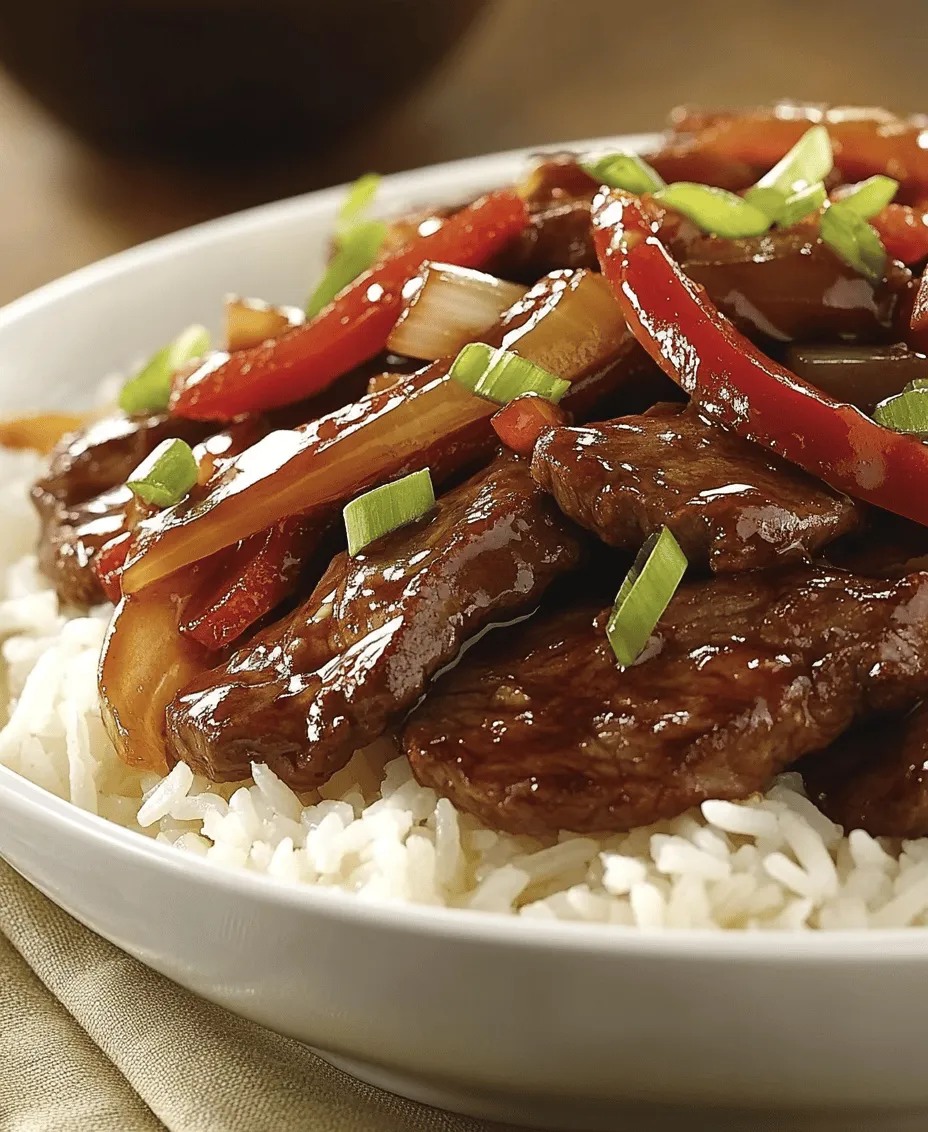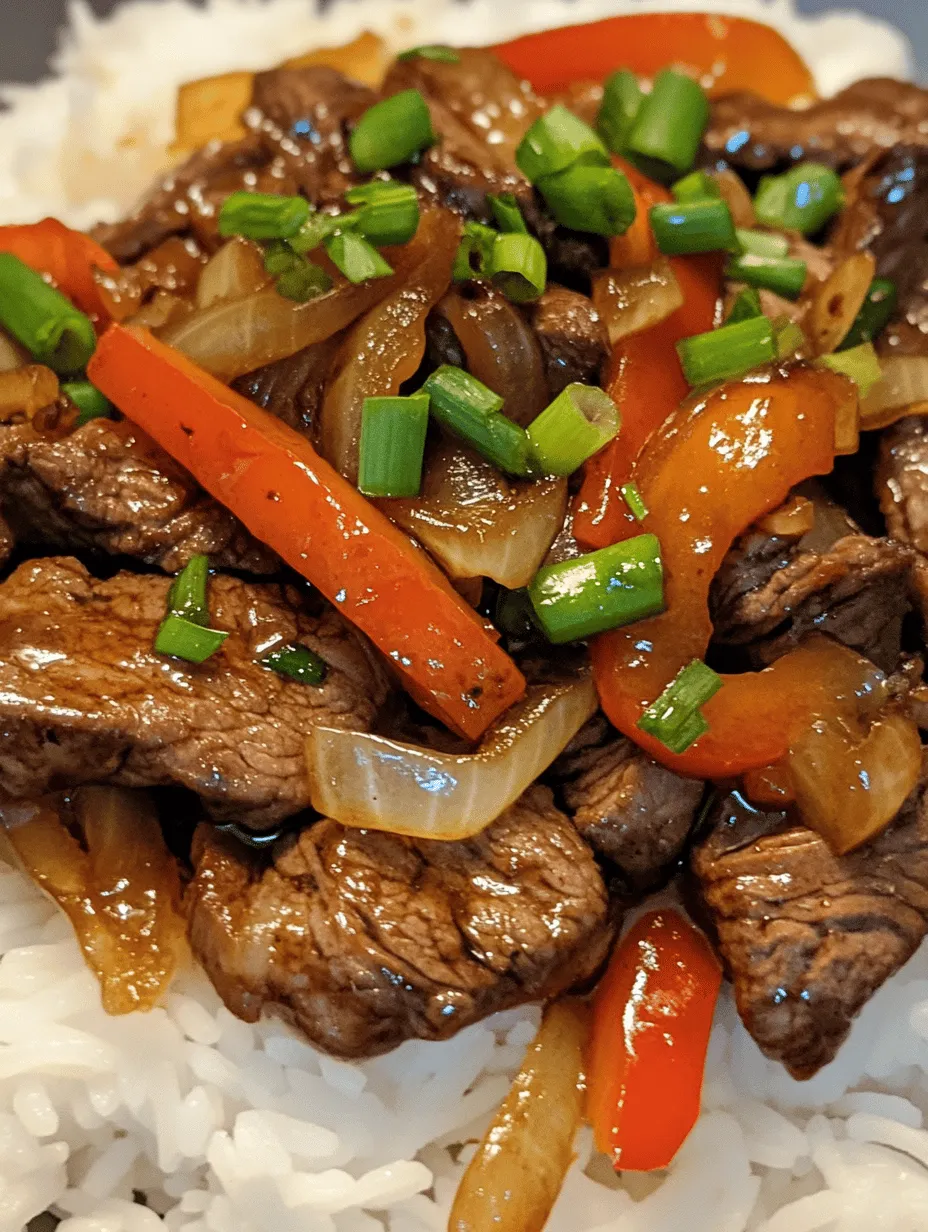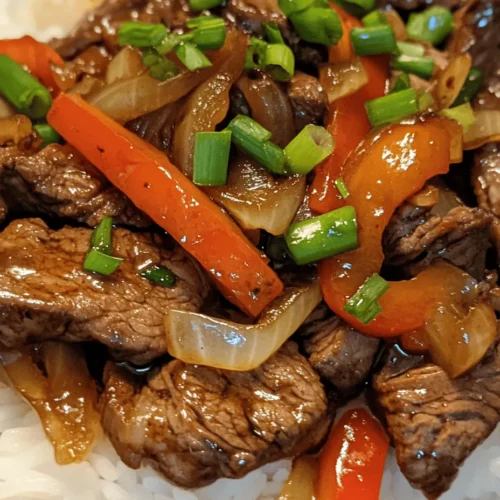Introduction
Chinese cuisine is a tapestry of flavors, aromas, and textures, with stir-frying as one of its most cherished cooking techniques. Among the myriad of dishes that exemplify this culinary art, Savory Chinese Beef and Onion Stir-Fry stands out for its simplicity and rich flavor profile. This dish is not only a staple in many households but also an embodiment of the balance found in traditional Chinese cooking—where protein, vegetables, and a savory sauce come together in perfect harmony.
Stir-frying is an age-old method that involves cooking food quickly at high heat in a wok or pan. The technique allows ingredients to retain their color, texture, and nutritional value, making it a healthy cooking option. The quick cooking process ensures that the beef remains tender and the vegetables crisp, resulting in a dish that is both visually appealing and deliciously satisfying.
This recipe highlights the robust flavors of marinated beef sirloin paired with caramelized onions and fresh vegetables, all enveloped in a savory sauce that tantalizes the taste buds. The balance of protein and vegetables, complemented by the umami-rich sauce, makes this stir-fry not only a delightful meal but also a nutritious choice for busy weeknights or special occasions.
Understanding the Key Ingredients
Beef Sirloin
When it comes to stir-frying, choosing the right cut of beef is crucial for optimal flavor and tenderness. Beef sirloin is often favored for this dish due to its balance of fat and lean meat. This cut is not only tender but also has enough marbling to keep the meat juicy during the quick cooking process. When sliced thinly against the grain, sirloin becomes exceptionally tender, making it perfect for stir-frying. Additionally, its rich flavor complements the savory sauces used in this recipe, elevating the overall taste experience.
Fresh Vegetables
A key component of any successful stir-fry is the inclusion of fresh vegetables. In this recipe, onions play a starring role, adding sweetness and depth to the dish. The sharpness of the onions mellows as they cook, providing a perfect counterbalance to the savory beef. Bell peppers add a pop of color and crunch, while garlic and ginger contribute aromatic notes that enhance the dish’s overall flavor profile. These vegetables not only add texture but also provide essential nutrients, making this meal as wholesome as it is delicious.
Sauces
The flavor of the stir-fry is largely influenced by the sauces used, and in this recipe, we’ll utilize soy sauce and oyster sauce. Soy sauce is a quintessential ingredient in Chinese cooking, known for its salty and umami flavor, which forms the backbone of many Asian dishes. It acts as a seasoning that enhances the natural flavors of the ingredients. Oyster sauce, on the other hand, adds a unique sweetness and depth, crafted from the natural juices of oysters. Together, these sauces create a savory blend that perfectly coats the beef and vegetables, delivering a mouthwatering taste of the East.
Cornstarch
Cornstarch plays an essential role in the preparation of this dish, particularly in marinating the beef. When mixed with the marinade, cornstarch helps to create a velvety texture that allows the beef to sear beautifully in the pan. This technique not only enhances the tenderness of the meat but also aids in achieving that coveted stir-fry finish—seared and flavorful, without being tough or chewy.
Sesame Oil
Lastly, sesame oil is a luxurious finishing touch that adds a distinct aroma and taste to the dish. With its nutty flavor, sesame oil enhances the overall dish, making it more aromatic and flavorful. A drizzle at the end of cooking can elevate the dish further, providing a subtle yet impactful flavor boost that ties all the elements together.
Marinating the Beef for Maximum Flavor
Marinating is a critical step that shouldn’t be overlooked when preparing beef for stir-fry. The marination process infuses the meat with flavor and helps to tenderize it, making it more enjoyable to eat.
Step-by-Step Process of Marinating Beef Sirloin
1. Prepare the Marinade: In a bowl, combine soy sauce, oyster sauce, a splash of rice wine or sherry, minced garlic, grated ginger, and a teaspoon of cornstarch. This mixture not only adds flavor but also ensures the beef is juicy and tender.
2. Slice the Beef: Take your beef sirloin and slice it against the grain into thin strips, about 1/4 inch thick. This technique is crucial, as cutting against the grain shortens the muscle fibers, resulting in a more tender bite.
3. Coat the Beef: Add the sliced beef to the marinade, ensuring that each piece is well-coated. Toss the beef gently to avoid tearing the slices.
4. Marinate: Cover the bowl with plastic wrap or transfer the beef to a resealable bag. Allow the beef to marinate for at least 30 minutes at room temperature. For deeper flavor, consider marinating for several hours or even overnight in the refrigerator. Just be sure to allow it to come back to room temperature before cooking.
Explanation of How Marination Enhances Tenderness and Taste
Marination is more than just a flavor enhancer; it serves a dual purpose of tenderizing the meat. The acids in the marinade (from the soy sauce and rice wine) break down the proteins in the beef, resulting in a more tender texture. Additionally, allowing the beef to soak in the flavors creates a depth that can significantly elevate the taste of the final dish. A well-marinated beef stir-fry is a delightful combination of flavor and tenderness that is sure to impress.
Recommended Time for Marinating and Tips for Best Results
For optimal results, aim for at least 30 minutes to 1 hour of marination. However, if time allows, marinating the beef for up to 4 hours or overnight will yield superior flavor and tenderness. When marinating overnight, be mindful of the sodium content in soy sauce, which can cause the meat to become overly salty if left too long. Always remember to let the beef come to room temperature before cooking; this ensures even cooking and helps achieve that perfect sear.
Preparing the Stir-Fry Sauce
The stir-fry sauce is the heart of this dish, bringing all the flavors together in a harmonious blend. Crafting the perfect sauce involves balancing various elements to achieve a savory, sweet, and umami-rich profile.
Breakdown of the Stir-Fry Sauce Components
The stir-fry sauce for this recipe is a simple yet flavorful concoction. Begin with a base of soy sauce and oyster sauce, which will provide the primary flavors. To enhance the sweetness, you can add a teaspoon of sugar or honey, balancing out the saltiness of the soy sauce. A splash of rice vinegar can introduce a touch of acidity, brightening the overall flavor. For an additional depth, consider including a dash of sesame oil and a sprinkle of black pepper.
Importance of Balancing Flavors
In Chinese cooking, achieving a balance between savory, sweet, and umami flavors is essential. The key to a successful stir-fry sauce is not just to replicate the flavors but to create a harmonious blend that complements the beef and vegetables. Adjust the quantities of each ingredient to suit your taste preferences—if you prefer a sweeter sauce, increase the sugar; if you prefer a more savory profile, add more soy sauce.
Tips for Customizing the Sauce to Personal Preferences
Feel free to experiment with the stir-fry sauce to make it your own. You can add chili paste or Sriracha for heat, or even a splash of hoisin sauce for an extra layer of flavor. If you’re looking for a gluten-free option, consider using tamari instead of soy sauce. The beauty of stir-frying lies in its adaptability; customizing the sauce allows you to create a dish that perfectly suits your palate.
Mastering the Stir-Fry Technique
The final step in bringing this dish to life is mastering the stir-frying technique. This cooking method is an art form that requires practice and attention to detail, but once mastered, it allows for rapid meal preparation without sacrificing flavor or quality.
Explanation of the Stir-Frying Process
To achieve the perfect stir-fry, ensure that all your ingredients are prepped and ready to go before you start cooking. Stir-frying is a fast-paced process that leaves little room for delays. Begin by heating your wok or a large skillet over high heat until it is hot. Add a tablespoon of vegetable oil (like canola or peanut oil) and swirl it around to coat the surface.
Once the oil is shimmering, add the marinated beef in a single layer, allowing it to sear without overcrowding the pan. This step is crucial as it creates that desirable char and locks in the juices. Stir the beef frequently to prevent burning, and cook it just until browned and cooked through, which typically takes just a couple of minutes.
After the beef is cooked, remove it from the pan and set it aside. In the same pan, add a bit more oil if necessary, and toss in the onions and any other vegetables you have prepared. Stir-fry them quickly until they are just tender but still crisp, usually around 2-3 minutes.
Finally, return the beef to the pan, pour in your prepared stir-fry sauce, and toss everything together to ensure an even coating. The high heat will help to caramelize the sauce slightly, enhancing its flavors and creating a glossy finish on the dish.
Mastering the stir-fry technique allows you to appreciate the beauty of Chinese cooking, where each element is treated with care to create a delightful and satisfying meal. The combination of tender beef, fresh vegetables, and rich sauce is a culinary experience that embodies the heart of Chinese cuisine.
In the next part of this article, we will delve deeper into the tips for achieving the best results with this stir-fry, as well as answer some common questions surrounding this popular dish. Stay tuned for more insights and culinary wisdom!




